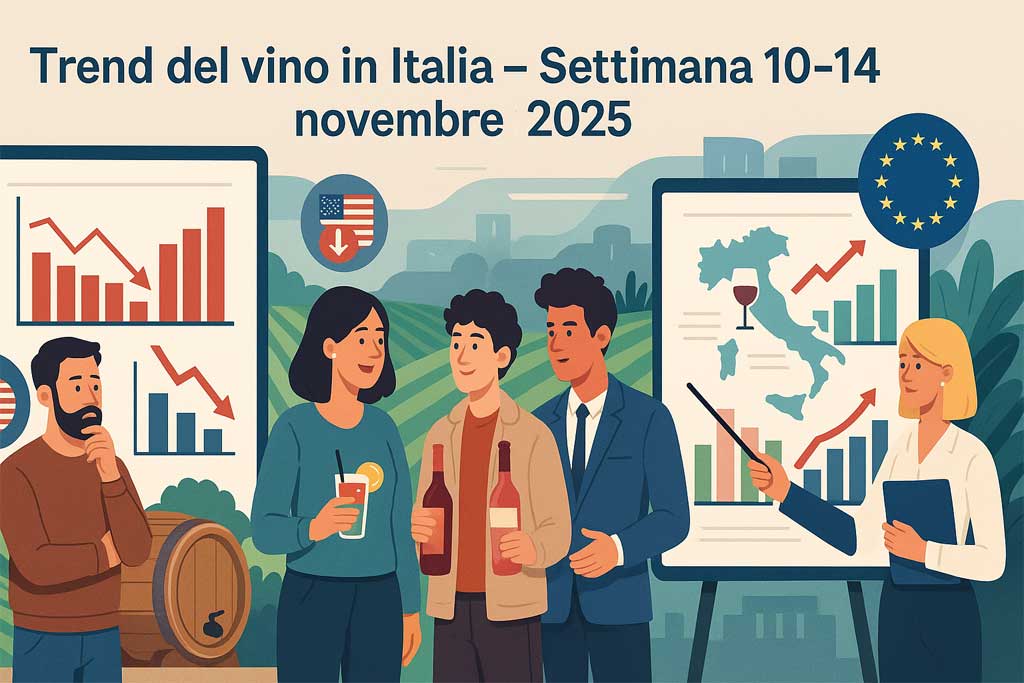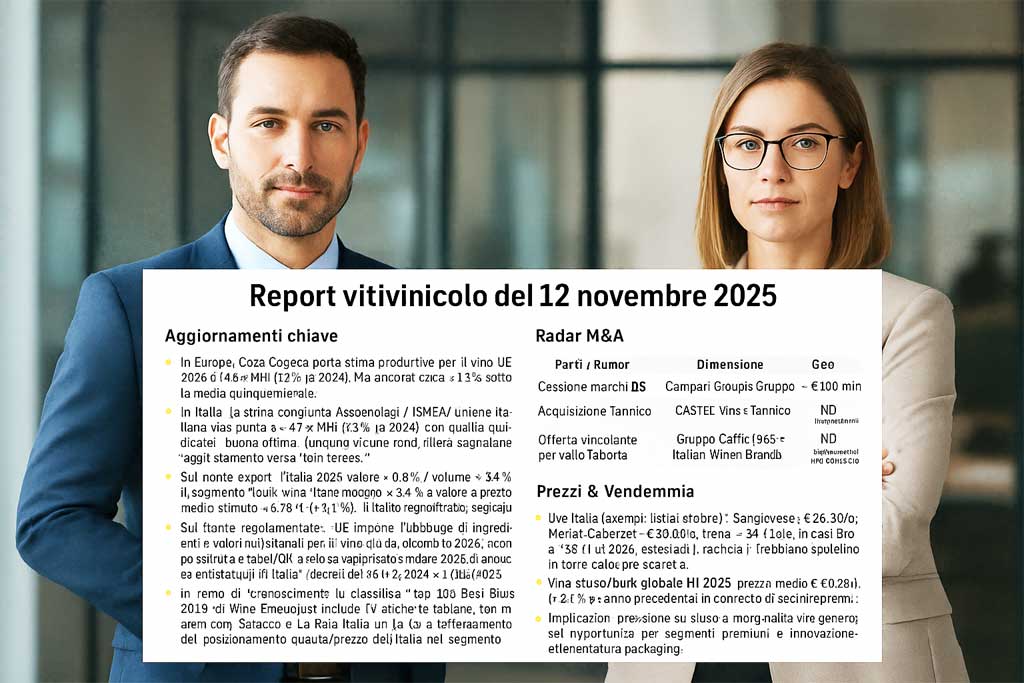The Italian wine sector is experiencing a phase in which signs of structural strength coexist with tensions on international markets, competitive pressures, and profound transformations in consumer habits.
Exports: United States struggling due to tariffs and unfavorable exchange rate
The U.S. market, the primary outlet for Italian wine, is experiencing a marked slowdown. The UIV Wine Observatory recorded a 28% drop in export volumes and a 13.5% reduction in average price (from $6.52 to $5.64/liter) in the two-month period July–August.
The tariffs introduced by the Trump administration and the weak dollar are compressing margins and jeopardizing the mid-market, which is exposed to competition from American producers. UIV emphasizes the need for effective cost sharing along the supply chain, while Frescobaldi encourages companies to strengthen their international presence with a medium- to long-term perspective.
Global scenario: slight recovery in production but still weak trend
According to OIV estimates, global wine production in 2025 is expected to reach 232 million hectolitres: 3% higher than in 2024, but still 7% lower than the five-year average.
Italy maintains its world lead with 47.3 million hectoliters, ahead of France and Spain. However, the recovery is patchy: the weather continues to slow many regions, including France, which recorded a 16% decline compared to recent years’ averages. Despite the fluctuations, the international market remains substantially balanced thanks to slowing demand.
Italy: Growing exports and consolidated quality
In 2025, the value of Italian exports will exceed 8.2 billion euros , confirming the country as the world’s leading exporter by volume and second by value after France.
Production is back on track after a decline in 2023, while domestic consumption remains stable (37.8 liters per capita, 8.5 million daily consumers). This growth, however, faces the uncertainties of US tariffs, which could potentially erode significant market shares.
Increasing inventories and slower markets
As of October 31, 2025, national inventories reached 44.5 million hectoliters , up 5.2% from the previous year. This high level is driven by a bountiful harvest and slower demand, especially in the US. Veneto, Emilia-Romagna, and Tuscany account for over 50% of the stocks; Prosecco, IGT Toscana, and IGT Puglia lead the ranking of the most commonly stocked denominations.
Consumption: France down and Gen Z moving towards low-alcohol
France is seeing declines in large-scale retail trade: still wines are down 3% in volume and value, reds are suffering significantly, and Champagne is declining. Prosecco, however, is booming (up 14% in volume).
At the same time, young European consumers are turning to low-alcohol drinks: ciders, non-alcoholic sparkling wines, Christmas spritzes, and alcohol-free mulled wines are becoming key features of the 2025 festivities, driven by a concern for well-being and sustainability.
Finance and mergers: the “Compagnia del Gusto” is born
The wine and food sector continues to be considered a strategic investment asset. The new holding company, Compagnia del Gusto, aims to bring together food and wine excellence—from seafood specialties to premium wines—with a strategy of international growth, innovation, and sustainability.
The project, structured around three business units (Compagnia del Mare, delle Vigne, and dei Sapori), aims to create a synergistic model for distribution, logistics, and local development, with a target turnover of €200 million.
European Policies: Progress in the “Wine Package”
Confagricoltura welcomes the new regulatory framework approved by the European Parliament: permits for replanting have been extended from three to eight years and EU funding of up to 80% for climate mitigation investments. However, critical areas remain to be addressed to truly strengthen European competitiveness.
Italian competitiveness: promotion and innovation as strategic levers
A clear need emerged from the Confcooperative conference: to secure the future of the sector with a long-term vision based on promotion, research, sustainability, and market development. Global consumption continues to decline for red wines, while white, rosé, and sparkling wines are growing.
Land Value: Barolo Leads the Ranking of Most Valuable Vineyards
The land market continues to show marked territorial disparities. Barolo reached record values of up to €2.3 million per hectare , followed by areas such as Bolgheri, Montalcino, Valdobbiadene, and Caldaro. Italy’s finest vineyards remain among the most sought-after agricultural assets internationally.
Awards: Italy already in Wine Spectator’s Top 10
Castello di Ama’s Chianti Classico San Lorenzo Gran Selezione 2021 has entered the provisional Top 10 of Wine Spectator’s “Top 100,” ranking at number 9, confirming the strong identity of Tuscan winemaking on global markets.
Conclusion
This week confirms a complex yet opportunity-rich picture: Italy maintains its manufacturing leadership and growing exports, despite facing more selective markets, changing consumers, and an uncertain geopolitical environment. The answers lie in innovation, aggregation, supply chain efficiency, and a more robust international strategy, elements that define the trajectory of future competitiveness.





